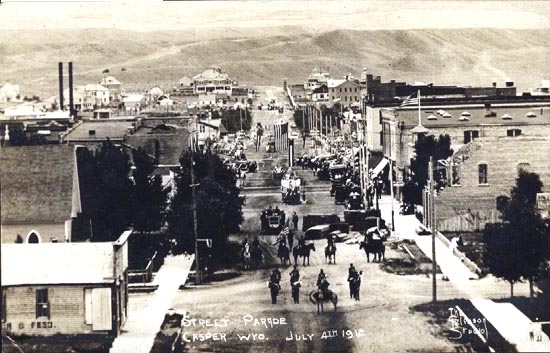
Center Street looking south, Fourth of July Parade, 1912.
Photo by Gleason Studio.
Immediately behind the horses is the City's fire truck newly purchased in 1911. The parade was a part of a
two and a half day celebration of the Fourth. The parade in addition to floats depicted below included horses,
three bands and twenty-five decorated automobiles. Other events included
three baseball games between Casper and Harrison, Nebraska (Harrison won all three), various foot races, pony races, hurdle races, a ring tournament, and a bucking contest with the
winner to received a $100 saddle. Undoubtedly, one of the more unusual races was the beer drinking contest.
entrants rode their horses along a route, stopping at "beer stations, and then consumed a pint of beer at each and then riding to
the next station and repeating the process. Carl Hildrebrand won the event.
The main activities were at the
Athletic Park south of the wool warehouses.
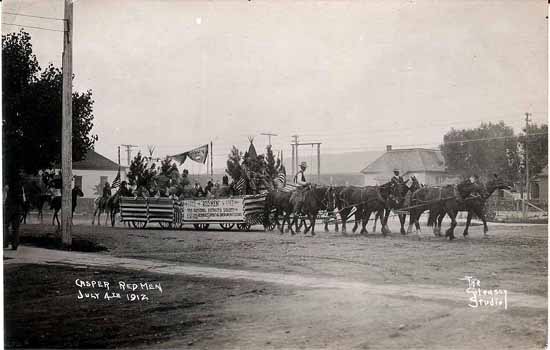
Popo Agie Tribe No. 10, Improved Order of Redmen float, Fourth of July Parade, 1912.
Photo by Gleason Studio.
The Improved Order of
Red Men trace their history back to the Sons of Liberty from the American Revolution and the Sons of St. Tamina.
The Sons of Liberty are famous for a tea party in Boston. Thus, the Order
claims to be the oldest fraternal order of American origin.
Lodges were called "Tribes" and the meeting hall was called a "Wigwam." Other
Redmen tribes were in Cheyenne, Laramie, Cambria, Fort D.A. Russell, Evanston, Rock Springs, Green River,
Rawlins, Carneyville, Cumberland, Kemmerer, Encampment, Newcastle, Douglas, Sheridan, Basin, Cody, Meeteetse, and Thermopolis.
The Order was organized similar to the Masons with a "Great Council" in each state. The Great Council of
Wyoming was chartered in 1907 and surrendered its charter to the Great Council of the United States on August 30, 1917. At the time the
Wyoming Great Council fire was extinquished, there were only four tribes left in Wyoming with less than 300 members.
[Information provided by the Red Men Museum and Library, Waco, Texas].
The officers of the individual tribes were
the "Sachem," Prophet, Senior Sagamore, Junior Sagamore, Chief of Records, Collector of Wampum, and
the Keeper of Wampum, equivilent to the Masonic Worthy Master, Chaplain, Senior Warden, Junior Warden, Secretary,
and Treasurer of a Masonic Lodge. The order also had a "fun" subordinate order equivilent to
the Masons' Shrine known as the "Haymakers." At one time, the Red Men had over
a half-million members nationwide. By 1995, national Red Men membership had dwindled to less than
38,000. In Casper, Popo Agie Tribe No. 10 was instituted in 1906.
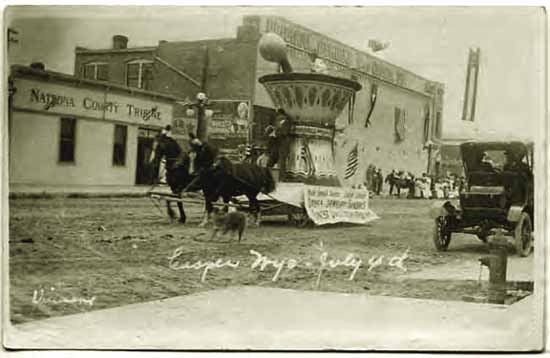
Float, Fourth of July Parade, 1912.
Note the fire hydrant. One of the first items of business for the town council after incorporation of the
town in 1889 was the organization of a fire department. The Town purchased 150 feet of hose, a nozzle, and a
trumpet for the chief. The items were dutifully hauled to each fire and proudly displayed unused while the fire
was fought with an old-fashioned bucket brigade. With completion of the water system in 1896, the
fire gear could finally be put to use.
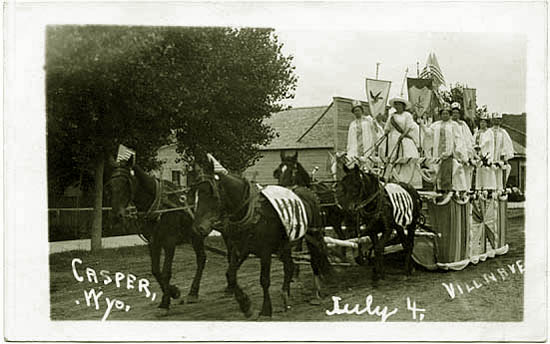
Float, Fourth of July Parade, 1912.
The winning float in the parade was for the Grand Central bar. With the success of the 1912 Fourth of July,
a bigger celebration was planning in 1913, lasting a full four days.
A major activity activity on the Fourth besides the
big parade featuring five bands were to be flights by
Dr. Frank J. Bell of Billings, Montana, in his big 85 horsepower Curtis Flyer aeroplane. No one was to be admitted to the
grand stands until after the flight. Unfortunately, on his first flight
Dr. Bell smashed the machine into a fence and it had to be shipped off for repairs.
Other activities included the Savidge Carnival Company from Nebraska which set up its merry-go-round and ferris wheel, the four flying Baldwins, an
exhibition of trained bears and the Farlow Brothers' Wild West and Indian Village from Lander. Stub Farlow and Willie Washakie each
gave exhibitions of trick roping.
Center Street was lined with booths. Concert stands for bands were set up the future site for the Midwest Hotel and at the
corner of Wolcott and Second. A quartet sang "Dixi," the "Star Spangled Banner," and "My Country 'Tis of Thee." At the Athletic Park there were mock capture of trappers by Indians, capture of an
Indian horse thief and rescue by the Indians. Horse back wrestling matches and a maypole dance by mounted cowboys and
cowgirls.
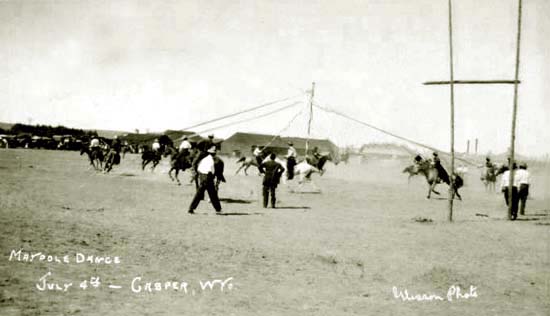
Maypole Dance, Casper, July 4, 1913. Photo by O. S. Gleason.
Unfortunately, besides the mishap with the aeroplane, crowds were smaller than expected. The following year, the festivities were
cut back a bit. The stores closed for the Fourth, Stub Farlow stayed home and participated in the Lander
Fourth of July. Based on reports in Casper papers, the big Fourth of July activity appeared to be the
wrestling matches at the Isis Theatre.
For the Fourth of July, 1915, a celebration was held at the Fair Grounds at which there was an attendance of 2,000. Morning activities included
a harness race, a cowboy race, a cowgirl race, the beer race. In the afternoon there was a ballgame between
Riverton and Casper. Riverton won 16 to 12.
The 1913 Fourth of July was not matched until the 1930 Casper Stampede put on by the American Legion. The Stampede was instituted by the
American Legion post in 1920 and was originally held in September. The 1930 celebration held on the Fourth of July drew illuminaries such as
Robert E. Carey, T. Joe Cahill, and Miss Caroline Lockhart, as well as reporters from New York and Chicago newspapers.
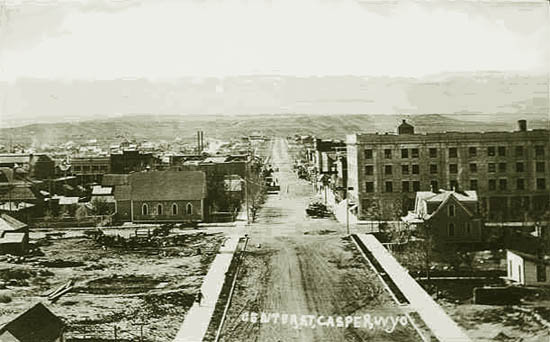
Center Street, looking south 1923.
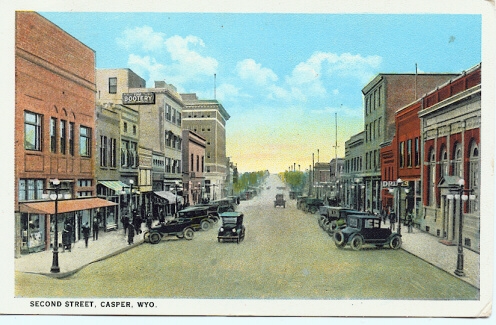
2nd Street, 1923
Casper Photos continued on next page.
|